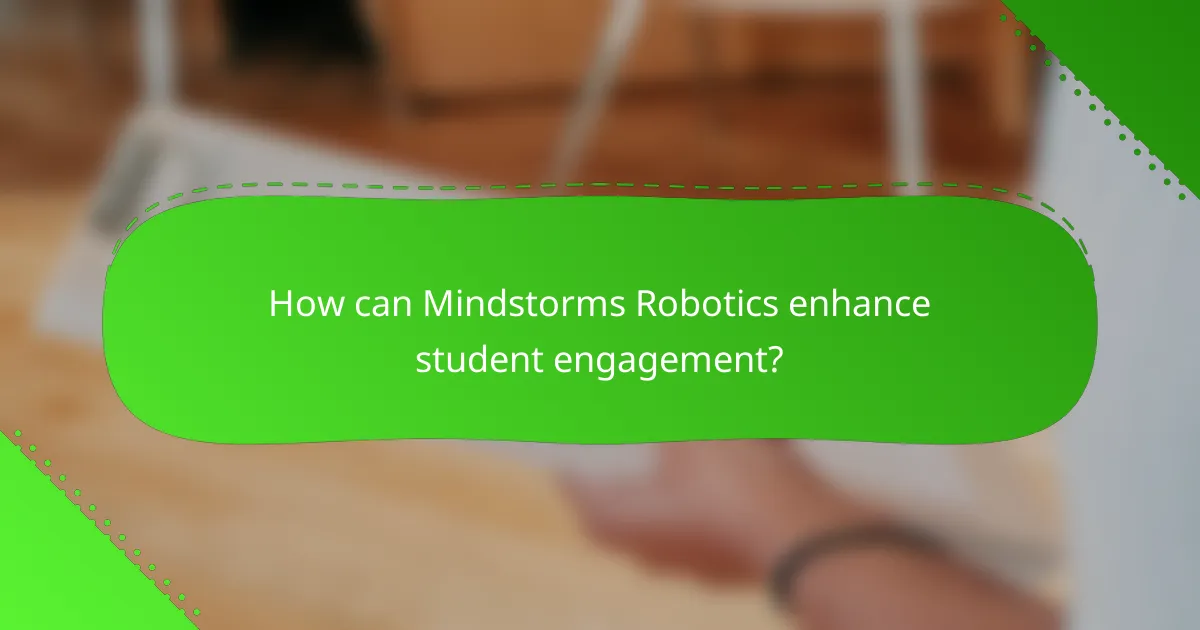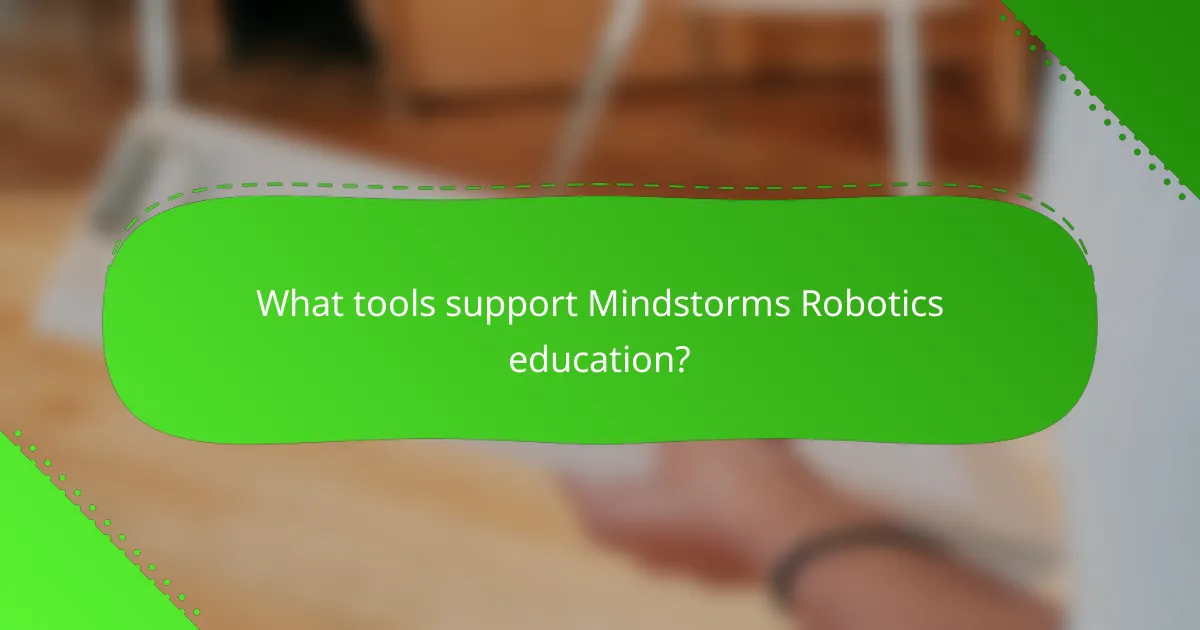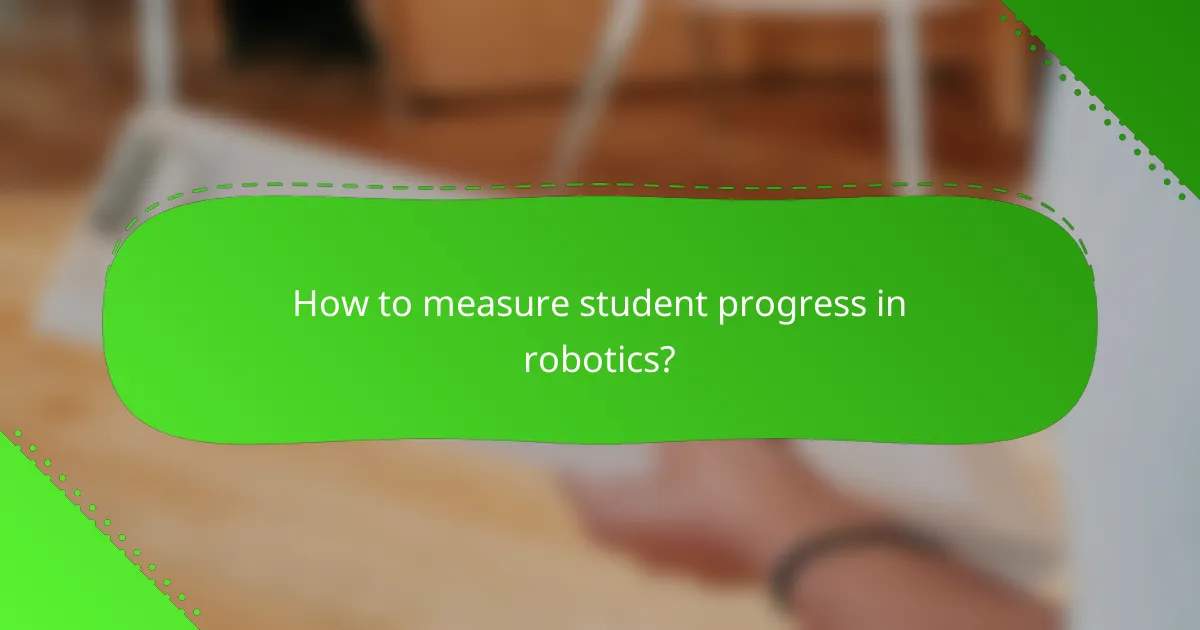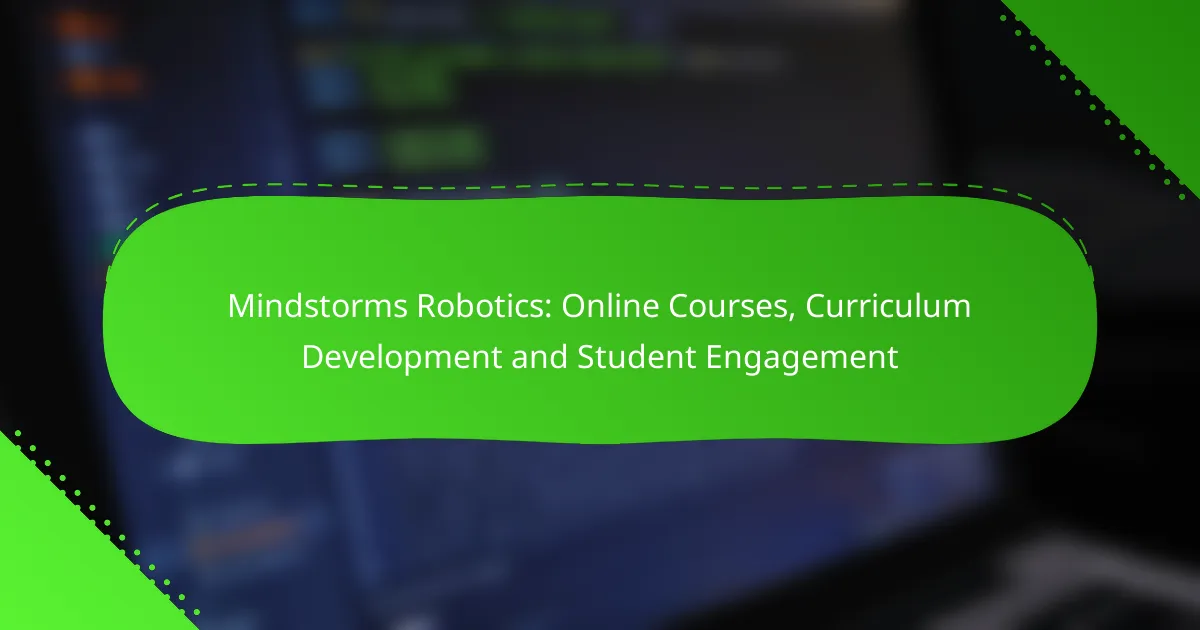Mindstorms Robotics offers an innovative approach to education by engaging students through hands-on learning experiences that enhance creativity and problem-solving skills. With a variety of online courses available, learners can explore programming, design, and certification tailored to their skill levels. Developing a curriculum around Mindstorms Robotics allows educators to integrate practical projects with theoretical concepts, fostering a deeper understanding of technology and robotics.

How can Mindstorms Robotics enhance student engagement?
Mindstorms Robotics can significantly enhance student engagement by providing hands-on learning experiences that stimulate creativity and problem-solving skills. Through interactive activities, students become active participants in their education, fostering a deeper understanding of robotics and technology.
Interactive learning modules
Interactive learning modules in Mindstorms Robotics allow students to explore concepts through practical application. These modules often include step-by-step tutorials that guide learners in building and programming robots, making complex ideas more accessible. For instance, a module might focus on programming a robot to navigate a maze, encouraging critical thinking and experimentation.
To maximize engagement, ensure that these modules are visually appealing and user-friendly. Incorporating multimedia elements like videos and animations can further enhance the learning experience, keeping students motivated and interested.
Gamification techniques
Gamification techniques integrate game-like elements into the learning process, making it more enjoyable and competitive. Features such as points, badges, and leaderboards can motivate students to complete tasks and achieve learning goals. For example, students might earn points for successfully programming their robots to complete challenges, fostering a sense of accomplishment.
When implementing gamification, balance competition with collaboration to ensure all students feel included. Avoid overly complex scoring systems that may confuse learners; instead, focus on clear, achievable objectives that encourage participation and skill development.
Collaborative projects
Collaborative projects in Mindstorms Robotics promote teamwork and communication among students. By working in groups to design and build robots, learners can share ideas and strategies, enhancing their problem-solving skills. A project might involve creating a robot that can perform tasks in a simulated environment, requiring students to brainstorm and implement solutions together.
To facilitate effective collaboration, establish clear roles within groups and set specific goals for each project. Encourage regular check-ins to assess progress and address challenges, ensuring that all team members contribute and learn from the experience.

What online courses are available for Mindstorms Robotics?
There are various online courses available for Mindstorms Robotics, catering to different skill levels and interests. These courses cover programming, design, and certification, allowing students to engage with robotics in a structured way.
Beginner programming courses
Beginner programming courses for Mindstorms Robotics introduce fundamental concepts of coding and robotics. These courses often use visual programming languages, making it easier for novices to grasp essential programming logic.
Typically, these courses cover topics such as sensor integration, motor control, and basic algorithms. Students can expect to complete simple projects, like building a robot that navigates through obstacles, which reinforces learning through hands-on experience.
Advanced robotics design courses
Advanced robotics design courses focus on more complex engineering principles and programming techniques. These courses often require prior knowledge of basic robotics and programming, allowing students to delve deeper into topics like artificial intelligence and machine learning applications in robotics.
Participants may work on projects that involve designing robots for specific tasks, such as competitive robotics challenges or automated systems. These courses typically emphasize problem-solving and critical thinking, preparing students for real-world applications.
Certification programs
Certification programs for Mindstorms Robotics validate a student’s skills and knowledge in robotics and programming. These programs often require the completion of several courses and a final project that demonstrates proficiency.
Upon successful completion, students receive a certificate that can enhance their resumes and showcase their expertise to potential employers. Many certification programs are recognized by educational institutions and industry leaders, making them valuable for career advancement.

How to develop a curriculum using Mindstorms Robotics?
Developing a curriculum using Mindstorms Robotics involves creating a structured approach that integrates hands-on learning with theoretical concepts. This process should focus on engaging students through interactive projects that enhance their understanding of robotics and programming.
Step-by-step curriculum framework
Start by defining the learning objectives for your curriculum, such as understanding basic programming concepts or building functional robots. Next, outline the key topics to cover, including robotics fundamentals, sensor integration, and programming languages like NXT-G or EV3-G.
Once the topics are established, design a sequence of lessons that progressively build on each other. Incorporate hands-on activities where students can apply their knowledge, such as building simple robots and programming them to complete specific tasks. Regular assessments can help gauge student understanding and adjust the curriculum as needed.
Integration with STEM standards
Align your Mindstorms Robotics curriculum with established STEM standards to ensure it meets educational requirements. Familiarize yourself with standards such as the Next Generation Science Standards (NGSS) or the International Society for Technology in Education (ISTE) standards, which emphasize critical thinking and problem-solving skills.
Incorporate elements from these standards into your lessons, such as encouraging collaboration during group projects or promoting inquiry-based learning. This alignment not only enhances the educational value of your curriculum but also prepares students for future academic and career opportunities in STEM fields.

What tools support Mindstorms Robotics education?
Mindstorms Robotics education is supported by a variety of tools that enhance learning and engagement. Key resources include specialized software, online collaboration platforms, and interactive learning environments that facilitate hands-on experience with robotics.
LEGO Mindstorms EV3 software
LEGO Mindstorms EV3 software is a powerful tool for programming and controlling robots built with the EV3 kit. It features a user-friendly interface that allows students to create programs using a visual block-based coding system, making it accessible for beginners while still offering advanced options for experienced users.
When using the EV3 software, educators should encourage students to experiment with different programming techniques and robot configurations. This hands-on approach fosters critical thinking and problem-solving skills. Additionally, integrating challenges and competitions can motivate students to deepen their understanding of robotics concepts.
Online collaboration platforms
Online collaboration platforms play a crucial role in Mindstorms Robotics education by enabling students to work together on projects, share ideas, and provide feedback. Tools like Google Workspace, Microsoft Teams, and Slack facilitate communication and document sharing, allowing for seamless collaboration regardless of location.
To maximize the effectiveness of these platforms, educators should set clear guidelines for communication and project management. Encouraging regular check-ins and utilizing shared documents can help keep teams organized and focused. Additionally, incorporating virtual meetings can enhance engagement and ensure all members contribute to the project.

What are the prerequisites for Mindstorms Robotics courses?
To effectively participate in Mindstorms Robotics courses, students should have a foundational understanding of programming and access to appropriate robotics kits. These prerequisites ensure that learners can engage with the material and apply their skills in practical scenarios.
Basic programming knowledge
A basic understanding of programming concepts is essential for Mindstorms Robotics courses. Familiarity with programming languages such as Python or Java can significantly enhance a student’s ability to write and debug code for their robotics projects.
Students should focus on grasping fundamental concepts such as loops, conditionals, and functions. Engaging in online tutorials or introductory programming courses can help build this foundational knowledge before diving into robotics.
Access to robotics kits
Access to a Mindstorms robotics kit is crucial for hands-on learning and practical application of concepts. These kits typically include various sensors, motors, and building blocks that allow students to construct and program their robots.
When selecting a robotics kit, consider options that align with the course curriculum. Popular choices include LEGO Mindstorms EV3 or the newer Robot Inventor kit. Ensure that the kit is compatible with the programming environment used in the course to facilitate a smooth learning experience.

How to measure student progress in robotics?
Measuring student progress in robotics involves evaluating their understanding and application of concepts through various methods. Effective assessment can include qualitative and quantitative measures that reflect both individual and group achievements.
Assessment rubrics
Assessment rubrics provide a structured framework for evaluating student performance in robotics projects. They typically outline specific criteria and performance levels, allowing educators to assess skills such as programming, design, and teamwork. A well-designed rubric can include categories like creativity, functionality, and adherence to project guidelines.
When creating rubrics, consider using a scale from 1 to 4 or 1 to 5, where each level corresponds to clear descriptors of performance. This helps students understand expectations and areas for improvement. Regularly revisiting and updating rubrics based on student feedback can enhance their effectiveness.
Project-based evaluations
Project-based evaluations focus on assessing students through hands-on robotics projects that require them to apply their knowledge in real-world scenarios. These evaluations can include individual or group projects, where students design, build, and program robots to solve specific challenges.
To effectively implement project-based evaluations, set clear objectives and deadlines. Encourage students to document their process, which can provide insights into their problem-solving strategies and collaboration skills. Consider incorporating peer assessments to foster a collaborative learning environment and provide diverse perspectives on performance.

What are the benefits of using Mindstorms Robotics in education?
Mindstorms Robotics offers numerous benefits in education, including enhanced engagement and improved problem-solving skills among students. By integrating hands-on robotics projects, educators can foster creativity and critical thinking, making learning more interactive and enjoyable.
Enhanced Student Engagement
Using Mindstorms Robotics captivates students’ attention and encourages active participation in their learning process. The hands-on nature of building and programming robots makes lessons more dynamic, allowing students to see the immediate results of their efforts.
For example, students can work on projects that involve designing robots to complete specific tasks, which can lead to increased motivation and enthusiasm for STEM subjects. This engagement often translates into better retention of concepts and skills.
Development of Critical Thinking Skills
Mindstorms Robotics promotes critical thinking by challenging students to solve complex problems through design and programming. As they encounter obstacles, students learn to analyze situations, brainstorm solutions, and implement their ideas effectively.
In practice, this might involve troubleshooting a robot that isn’t functioning as expected, requiring students to think logically and systematically. Such experiences build resilience and adaptability, essential skills for future academic and career success.
Collaboration and Teamwork
Mindstorms Robotics projects often require students to work in teams, fostering collaboration and communication skills. By collaborating on building and programming robots, students learn to share ideas, delegate tasks, and support each other in achieving common goals.
This teamwork can mirror real-world scenarios, preparing students for future work environments where collaboration is key. Educators can encourage this by assigning group projects that require diverse roles, such as designer, programmer, and presenter.
Real-World Applications
Integrating Mindstorms Robotics into the curriculum helps students connect theoretical knowledge with real-world applications. Robotics projects can illustrate concepts in physics, engineering, and mathematics, making abstract ideas more tangible.
For instance, students can learn about sensors and programming logic while building a robot that navigates a maze, directly applying their classroom learning to a practical challenge. This relevance can enhance student interest and understanding of STEM fields.
